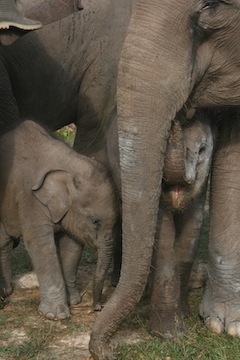|
|
|
|
 |
|
Indonesia: Muslim
With over over 200m believers (88% of its citizens) Indonesia has the largest Muslim population in the world. The islands that make up Indonesia are also home to many endangered species whose existence is threatened by a combination of habitat destruction, environmental pollution and illegal hunting for ivory and body parts. The iconic Sumatran tiger, elephant and rhinoceros populations are among those at serious risk of destruction.
Greening the Hajj
Every year some 200,000 men, women and young people travel from Indonesia each year on Hajj (a pilgrimage to Mecca during the special month of Hajj) or Umrah (a pilgrimage to Mecca or Medina that can be taken at any time of year). Because of the potentially huge numbers wishing to make the journey and pressure on resources at the pilgrimage sites this operates on a strict quota system by district.
The significance of the environmental impact of Indonesian pilgrims - all of whom fly from the Pacific to Saudi Arabia - meant that producing a Bahasa Indonesian version Green Guide to Hajj was a high priority. Following translation and editing by noted Indonesian environmentalist and academic Dr. Fachruddin Mangunjaya the Haji Ramah Lingkungan (Bahasan Indonesia translation of the original English edition of Green Guide to Hajj by Dr Husnah Ahmed) was released in June 2012.
In his foreword to the book, Dr. K.H. Ma’aruf Amin, the chairman of Indonesian Ulema Council (MUI), Indonesia’s top Muslim clerical body, states that Islam advocates environmental responsibility, because “this Earth is the biggest blessing from Allah and humans have been asked to cherish it and take care of it as a mandate.” He further writes that “Not only that, but humanity is also asked to do something better, and not to waste, or exceed the limits of Earth’s provisions.”
The publication was welcomed and supported by the Indonesian Ulema Council (MUI) and the Ministry of Environment Republic of Indonesia. The Chairman of the Institute for Research and Community Service (LPPM) at the National (Nasional) University, Prof. Dr. Ernawati Sinaga, M.S.,Apt described the launching of this book as “the first real step by the Education institutions in Indonesia to join with Indonesian society to take a role together to change people’s environmental behavior.”
The Green Guide in action
 |
 |
 |
Indonesian pilgrims prepare for Hajj by using the Green Pilgrimage questionnaire |
Following its publication the Green Guide was widely distributed and used in advance of the 2012 Hajj season. The first edition of 1000 copies was distributed through a specially designed travelling exhibition display which was launched in Binjai, North Sumatra in September 2012 just as a large group was about to begin their Umrah. Each of the 263 pilgrims was presented with a copy of Haji Ramah Lingkungan by the Mayor of Binjai and many completed questionnaires designed to raise awareness of key areas of environmental harm such as using (and discarding) plastic bottles and bags as they pass along..
The exhibition was later displayed at the mosque of Majelis Zikr Azzikra, in Bogor, West Java where an estimated 10,000 people were thought to have attended in 24 hours. The guide provided a helpful questionnaire to make pilgrims aware of the environmental implications of their choices in travelling, eating, using plastic containers and so on. Other advice included asking every pilgrim to plant a tree sapling in their own district before leaving. This would not only help offset the carbon footprint of flying but also remind people of the problems of deforestation faced by the country.
In November 2013 a special meeting was held between Dr Fachruddin Mangunjaya of the Center for Islamic Studies (who translated the Green Guide into Bahasa Indonesian) and the technical team at the Directorate of Hajj and Umrah Service. During the meeting Dr Fachruddin had the chance to meet the organisation's Director, Sri Ilham Lubis, who responded very positively with proposals for actions including the planting of trees by pilgrims at Hajj
dormitories along the way.
Historic fatwa for wildlife
 |
 |
 |
The Sumatran elephant - a seriously endangered species |
In March 2014 the Indonesian Council of Ulama (MUI) issued a fatwa, or edict, requiring the country’s 200 million Muslims to take an active role in protecting threatened species including tigers, rhinos, elephants and orangutans. The fatwa was one of the first of its kind in the world and was accompanied by an education programme to help communities put it into practice.
“This fatwa is issued to give an explanation, as well as guidance, to all Muslims in Indonesia on the sharia law perspective on issues related to animal conservation,” said Dr Hayu Prabowo, head of the MUI’s Agency for Honouring Environment and Natural Resources, an agency established in 2010 with the aim of contributing to Indonesia’s environmental well being. “Animals are viewed in Islam as being key parts of an ecosystem that in the end, also benefits the livelihood of human beings,” Dr Hayu added.
The edict reinforced the Indonesian government’s policies on preserving and protecting threatened animals and it was aimed at providing legal certainty on the question of Islam’s perspective on animals classified as “vulnerable”, “endangered” or threatened with extinction.
|
 |
|
|
|
|
|

